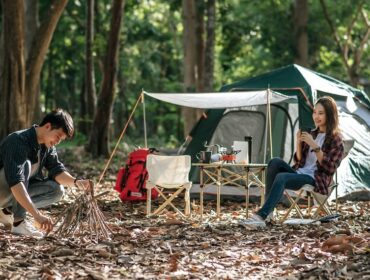Welcome to bear country. If you’re going hiking or camping in North America, it’s likely you’re going hiking where black bears, grizzly bears, or polar bears live. Many of our national parks, forestlands and most popular destinations share space with these omnivores. To truly enjoy backcountry camping, it’s best to know how to protect yourself from bears. There is research and gear to help you coexist with bears and enjoy the outdoors without hurting yourself or any wildlife. The more time you spend in the wild, the higher your chances of a bear encounter become.
But first, let’s get one thing out of the way: overall, the possibility of being attacked by a bear is low. That possibility becomes even more rare when you know exactly what to bring and what to do when you see one of these majestic animals. However, it’s good practice to assume that all bears are potentially dangerous and every encounter should be taken extremely seriously.
Here’s your bear country safety checklist:
- Plan ahead
- Pack to protect
- Camp with confidence
Plan Ahead
The fact is: If you’re adventuring into bear country, you might just encounter a bear. Some would say you’d be lucky to be in the presence of any bear. Regardless if you see one or not, it’s best to plan ahead and be prepared. When it comes to any bear in any environment, there’s a few tips that can be very helpful.
Some Bear Basics
- Always bring bear spray. Whether you end up using it or not, this is a staple that has the potential to save your life.
- Never feed a bear (or any wildlife). This encourages bears to become desensitized and no longer afraid of humans. Human food is also not healthy for wild animals nor do they need it to survive.
- Always use bear-safe containers when camping in bear country. While you’re asleep or away from camp, it’s likely that wildlife is going to check out your campsite. If a bear finds food, it will eat it. Then, it will most likely be back for more which is extremely dangerous. That’s why it’s vital that you use a bear-safe box (some national parks will have these at designated campsites) or a bear-safe food canister.
- Never surprise a bear. This goes for all wildlife. Although, when you shock a bear, it’s more likely to become violent. This is where a bear bell comes in handy on the trail so all wildlife can hear you coming.
- #1 and #2 can attract bears (and other wildlife). Use the toilet at least 100 feet away from your camp or stash your wag bag in a bear vault.
- It’s a mutually beneficial relationship when bears are scared of humans. A “nuisance bear” is one who has become desensitized to people and continues to push boundaries and can become dangerous. Please don’t try to have a “moment” with a bear by getting too close for a photo. It’s not worth it.
- Bears can be more aggressive right before hibernation. In the late summer and fall, bears will enter in their hyperphagia phase and bulk up eating up to 20,000 calories a day. The best thing to do during this time of year is consider every bear “hangry” and avoid encounters at all costs.
- Never try to escape a bear encounter or attack. Never try to run from, approach, or try to out-climb a bear. This is where you can put yourself in an extremely dangerous situation because humans cannot out-run or out-climb any bear. At no point during an attack should you try to escape by running, climbing, or swimming. It will catch you.
- Travel in groups. While adventuring solo has plenty of allure — the bigger your group, the louder, bigger, stinkier and stronger you’ll be in case of an encounter.
- If you see cubs, the mother bear is nearby. That being said, do not approach baby bears under any circumstance.
Identify the Bear
When you’re planning your next camping trip into the backcountry, do some research on the wildlife in that area. For example, if you’re going to Yellowstone National Park, you’ll find that this a high density area of grizzly bears (brown bears) and black bears. Once you identify the bears in the area, you can freshen up on what to do in the rare case of an encounter. The good news is, there’s only three species of bears found in the United States: black bears, grizzly bears and polar bears. The bad news is, black bears and black bears can look very similar so it’s vital to know about the species so you can best assess how to respond.
Encounters and Attacks

Black Bears
Black bears are the most common species of bear in North America. They’ve been known to be easy to scare away. But if you’re on the trail and a black bear becomes aware of you, you must stand your ground.
If you encounter a black bear and it begins to approach you, you’ll want to make yourself look bigger and stronger by raising your arms, hiking poles or backpacks. Begin to look around to find a nearby rock or stump to climb onto to appear even taller. Even if the bear isn’t coming any closer, you can yell “Whoa bear!” and clap your hands loudly to further prove to them that you’re not worth the interest. If the bear continues to pursue you, find your bear spray and get ready to use it as you fight back. In the rare occurrence that you are attacked, do not play dead. Fight back with everything you have and continuously aim toward the face and muzzle.
One way to remember what to do when you see a black bear is the phrase: “Black bear = big”
This way it’s easier to remember that when you see one of these bears, you’ll know to get big and loud to strategically ward off the bear.

Grizzly Bears (Brown Bears)
Grizzlies are also known as brown bears because of the most common color of their coats. No matter the name, these bears are known to be more aggressive and therefore, more dangerous than black bears. The best and easiest-to-spot identifier is the large hump between a grizzlies’ shoulders.
If you encounter a grizzly bear, do not run and don’t attempt to look big and sound loud. This is the most important differentiation to be aware of. When you encounter the more aggressive grizzly, your attempts to prove how big and loud you are will not succeed. Be sure to avoid eye contact and speak in a soft, monotone nature. Next, you’ll need to identify where your bear spray is, slowly grab it, remove the safety lock, and prepare to use it.
In the rare occurrence that you are attacked, you should play dead with your hands protecting your neck and legs spread so the bear cannot turn your body over. It’s extremely important to remain calm and try to wait until it’s over because fighting back usually makes the attack more deadly. If the attack continues, you must begin to fight back using whatever you have to continuously aim toward the face and muzzle.
One way to remember what to do when you see a brown bear is the phrase: “Brown bear = small”
This way it’s easier to remember that when you see one of these bears, you’ll know to get small and appear submissive.

Polar Bears
The largest and easiest to identify bear of the three North American species is the polar bear. The polar bear is the largest species of bear in the world, making it pretty terrifying. However, many adventurers will never cross paths with these massive bears. If you do venture into the Arctic Circle, it’s helpful to know how to handle an encounter and possible attack.
The likelihood of a polar bear attack is very rare but it’s important to note that it’s more likely at night. Similar to a grizzly attack, your best defense is going to be your bear spray and giving it everything you’ve got.
Pack to Protect
Now that you know how to identify and react to bears in the wild, let’s talk bear gear. It’s essential that you bring three things with you on any camping or backpacking trip in bear country. As someone that has all of these, you’ll soon find out why they have become a staple in backcountry adventuring even if you’re not in an area that’s known to have many bear sightings.
- Bear resistant canister to protect your food from bears and bears from your food
- Bear bell so you don’t surprise any
- Bear spray holster that keep your bear spray close by in case of an attack
A bear resistant canister is the most important item to keep unwanted wildlife away from your campsite. BearVault has become an instant favorite in this category for backpackers and campers. The company has received product approval from both the Sierra Interagency Black Bear Group (SIBBG) and the Interagency Grizzly Bear Committee (IGBC), and won the Editors’ Choice award from Backpacker magazine in 2004. BearVault canisters are also certified to withstand over one hour of non-stop testing from bears. The lightweight polycarbonate canisters are wide-mouthed so it’s easy for humans to get in and out, but nearly impossible for bears and other wildlife.
When choosing the right canister for you, you’ll need to know how many days worth of food you plan to pack for your trip. For example, there are two options currently available at Sunnysports…

BearVault BV500 Solo Bear Resistant Food Canister
This canister can hold up to 7 days worth of food. This option is great for longer backpacking or camping trips that will require you to pack food for many days.

BearVault BV475 Trek Bear Resistant Food Canister
This is a slightly smaller option, but can still pack 5-6 days. This is optimal for group or family trips to keep bears away when on the trail.

BearVault BV450 Solo Bear Resistant Food Canister
This bear canister can fit food for up to four days. This is a great option if you don’t want to carry the larger option. And remember, It’s best practice to store your canister at least 100 feet from your campsite at night and while you’re away.

BearVault BV425 Sprint Bear Resistant Food Canister
This is the smallest of bear canisters, meant for about 1-2 days in the backcountry. If you are planning a quick overnight trip and only need to bring minimal food, this is the perfect option for you.
Camp with Confidence
You’ve done the research on the area, identified the bears that live there, and brushed up on what to do if you see one. Now, you’re ready to get on the trail with peace of mind. When it comes to protecting yourself from bears while you’re camping, you’re also protecting them from us. Bears are an icon of the American wilderness. They have long been admired and portrayed in culture — from mythology, constellations, mascots and movies. Now it’s up to us, the adventurers, to preserve and honor their place in the North American wilderness.
Oh, and don’t forget, black bear = big, brown bear = small.
Article by Christin Workman
Christin (she/her) is a writer and outdoor enthusiast. She’s a backpacker, hiker, ‘baby’ climber and a stop-and-smell-the-wildflowers kind of adventurer. Christin lives in Colorado with her husband, Rhodesian Ridgeback and a myriad of plants. When she’s not playing with words, she’s either out in backcountry, tending to the garden or practicing aerial arts.




